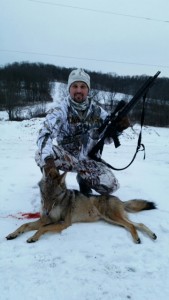Good hunters know their game: its habits, its habitat and its typical behaviors. All that plus its likes and dislikes, its favorite seasonal foods and its expected reaction to unwelcome scent, sight and sound.
All that and more comes with lessons learned in various ways, including the written word.
Experience
Now, thanks to the personal experiences, the research and the shared knowledge of other experts, comes a fine piece of writing perfectly suited to the growing army of coyote hunters, only recently published by author and serious predator hunter Michael Huff, a Pennsylvania guide, talented writer and skilled wildlife photographer.
Huff’s Understanding Coyotes, The Comprehensive Guide For Hunters, Photographers, and Wildlife Observers is over 100 pages of information that is truly all about coyotes.
My copy is already stuffed with pen marks, checks, circles, and scribbles, meaning that Understanding Coyotes has earned a place my shelf that is tagged Must Read – Again.
Three types

Huff covers three types of coyotes which are resident, sispersers, and transients and why each offer different opportunities for hunters. Of the three, according to Huff, resident coyotes are the easiest to call and kill.
Dispersing coyotes are young of the year animals that have been encouraged by the resident Alpha pair to leave home. These coyotes are striking out for a new home, maybe a brand new neighborhood or one with resident coyotes that will welcome it into their family group.
No inbreeding
Huff suggests that it is nature’s way of avoiding inbreeding and instead, adds fresh genes to another group. Transient coyotes are animals that are simply on the move, perhaps to settle somewhere and perhaps not. These migrants can be found one day and gone the next, impossible to pattern and especially tough to hunt.
Coyote diet
The chapter on coyote diet is interesting and informative, derived from studies of scat samples to identify visible pieces and parts which vary greatly from region to region and even season to season. Of course, deer and other mammal remains are found throughout the opportunistic coyote menu but so are fruits and grasses.
Deer in diet
Some regional results indicated that deer can be a significant portion of the diet. Something derived from this section of Understanding Coyotes may play a role in slowing the recovery of the Ohio deer herd, which has been drastically reduced to the point that hunters are reporting an apparent and disappointing absence of deer.
So the premise is that an overabundance of coyotes can have a negative effect on efforts to bring the deer herd back to at least a manageable size.
Growing coyote population
Understand that in the past several years of plentiful deer the corresponding number of coyotes grew tremendously. Now that the deer herd has been severely reduced, the number of coyotes remains high and their need for food can retard the re-growth of the deer herd.
Of course only time will tell if the coyote/deer relationship levels out.
Super senses
Another very informative chapter describes scientifically the super senses that coyotes possess like hearing warning sounds that scream “human in the room” to a wary coyote; things as insignificant as a jacket zipper or distant cough.
That plus eyesight far superior to a human’s and the ability to smell even when exhaling.
Huff’s Understanding Coyotes is a well written and enlightening book that is a nice mix of how, why, and why not, a real look at these incredible predators.
Look for the book in stores, on-line, or contact Huff at UNDERSTANDINGCOYOTES@GMAIL.COM.













